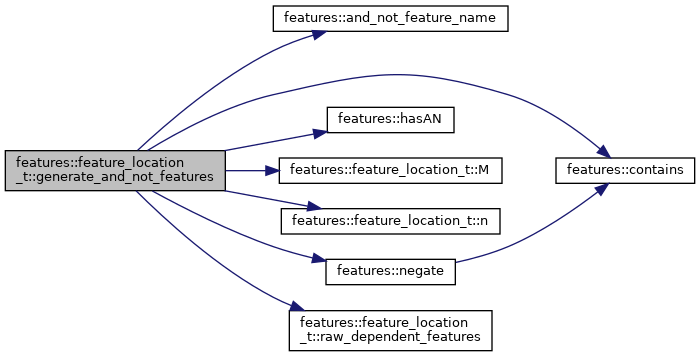#include <features.hpp>

Public Member Functions | |
| feature_location_t (feature_id_t n_, feature_id_t m_) | |
| const auto & | n () const |
| const auto & | F () const |
| const auto & | S () const |
| const auto & | M () const |
| const auto & | O () const |
| const auto & | A () const |
| const auto & | N () const |
| const auto & | ON () const |
| const auto & | AN () const |
| const auto & | DF () const |
| const auto & | T () const |
| const auto & | D () const |
| feature_names_t | generate_independent_features (const std::vector< feature_id_t > &f) const |
| feature_names_t | generate_or_features (const std::vector< feature_id_t > &f) const |
| feature_names_t | generate_and_features (const std::vector< feature_id_t > &f) const |
| feature_names_t | generate_not_features (const std::vector< feature_id_t > &nf) const |
| feature_names_t | generate_or_not_features (const std::vector< feature_id_t > &nf) const |
| feature_names_t | generate_and_not_features (const std::vector< feature_id_t > &nf) const |
| system_t | generate_system (const std::vector< feature_id_t > &f) const |
| systems_t | generate_all_systems () const |
| const std::vector< feature_id_t > & | raw_independent_features () const |
| const std::vector< std::vector< feature_id_t > > & | raw_dependent_features () const |
| const auto & | all_systems () const |
| void | print_header (std::ostream &os=std::cout) |
| void | print_systems (std::ostream &os=std::cout) |
Detailed Description
Base class for all classes that perform feature location.
Constructor & Destructor Documentation
◆ feature_location_t()
|
inline |
Constructor that requires the number of idependent features and the number of the model as parameters.

Member Function Documentation
◆ A()
|
inline |
Returns the actual number of and-features.

◆ all_systems()
|
inline |
Returns a collection wjth all systems.

◆ AN()
|
inline |
Returns actual number of and-not-features.

◆ D()
|
inline |
Returns the number of all possible set differences of SPL systems.

◆ DF()
|
inline |
Returns the actual number of inherently dependent features.

◆ F()
|
inline |
Returns the number of independent features, same as n().

◆ generate_all_systems()
|
inline |
Returns a collection of all systems of the SPL.


◆ generate_and_features()
|
inline |
Creates and returns a collection with all names of and-features. Takes raw feature IDs for single system.


◆ generate_and_not_features()
|
inline |
Creates and returns a collection with all names of and-not-features. Takes raw feature IDs for single system.


◆ generate_independent_features()
|
inline |
Creates and returns a collection with all names of independent features. Takes raw feature IDs for single system.


◆ generate_not_features()
|
inline |
Creates and returns a collection with all names of not-features. Takes raw feature IDs for single system.


◆ generate_or_features()
|
inline |
Creates and returns a collection with all names of or-features. Takes raw feature IDs for single system.


◆ generate_or_not_features()
|
inline |
Creates and returns a collection with all names of or-not-features. Takes raw feature IDs for single system.


◆ generate_system()
|
inline |
Creates and returns all feature names that define a system. Takes raw feature IDs for single system.


◆ M()
|
inline |
Returns the number of selected model.

◆ n()
|
inline |
Returns the number of independent features, same as F().

◆ N()
|
inline |
Returns the actual number of not-features.

◆ O()
|
inline |
Returns the actual number of or-features.

◆ ON()
|
inline |
Returns actual number of or-not-features.

◆ print_header()
|
inline |
Prints header for results of feature location analysis. Takes output stream as parameter with std::cout as default value.

◆ print_systems()
|
inline |
Prints all systems with the features that define them. Takes output stream as parameter with std::cout as default value.

◆ raw_dependent_features()
|
inline |
Returns a collection with collection of raw feature IDs that represents dependent features (with the exception of not-features).

◆ raw_independent_features()
|
inline |
Returns a collection with raw independent feature IDs.

◆ S()
|
inline |
Returns the number of systems of SPL.

◆ T()
|
inline |
Returns the actual total number of features.

The documentation for this class was generated from the following file:
- src/features/features.hpp